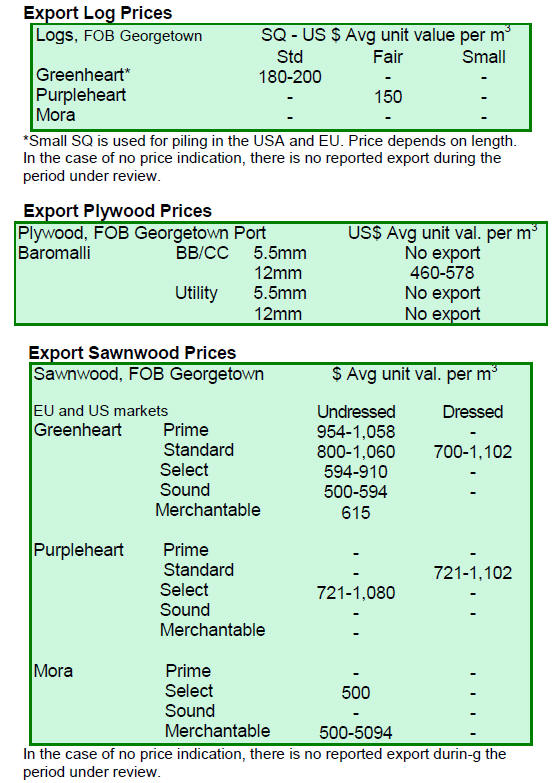2. GHANA
Surprising increase in gmelina log exports
According to data from the Timber Industry Development
Division (TIDD) of the Forestry Commission (FC), export
contracts approved in the fourth quarter of 2013 totalled
78,855 cubic metres, a slight increase on third quarter
2013 levels. The table below shows the breakdown by
product category.
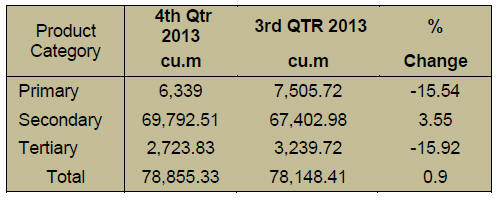
Exports of primary products fell over 15% to 6,339
cu.m
in the fourth quarter of 2013 compared to the previous
quarter. This, say analysts, was because of the sharp fall in
teak log exports.
The decline in teak log export volumes was partially
compensated for by an increase in gmelina log exports to
India which jumped to 6000 cu.m in the fourth quarter.
Exports of product categorised as secondary in TIDD
statistics (mainly sawnwood) increased by 3.6% compared
to the previous quarter and amounted to 69,792 cu.m.
However, exports of tertiary products fell sharply (down
16%) to just 2,724 cu.m in the fourth quarter.
Rosewood and teak sawnwood exports increased in the
fourth quarter. Rosewood exports amounted to 16,125
cu.m, up 30% on levels in the third quarter, mainly for the
Chinese and Indian markets, while sawn teak exports rose
11% to 8,130 cu.m.
Ghana’s plywood exported mainly to regional
markets
Rotary cut veneer exports in the fourth quarter fell a
massive 79% but exports of sliced veneer improved and
were up 14%. In the final quarter of 2013 exports of
plywood to neighbouring countries fell by 3% but, despite
the fall, the regional markets continued to be the main
markets for Ghana‟s plywood.
Of the 13,664 cu.m of plywood contracts approved, 94%
in terms of volume was shipped to countries in the West
Africa sub region with Nigeria being the major
destination.
Most exports of the tertiary products, such as sliced veneer
and kiln dried lumber were for the European markets. The
United States continues to be the major market for
mahogany and cedrella sawnwood as wel as for rotary
veneer. The Middle East and Egyptian markets emerged
as major importers of Ghana‟ „backing grade‟ veneer.
Hong Kong business mission to Ghana
A Delegation from the Hong Kong‟s Trade Development
Council (HKTDC) visited Ghana in early April to meet
and discuss investment potential with local businesses.
The delegation expressed interest in business partnerships,
distributorships and wholesaling. The mission was
endorsed by the Association of Ghana Industries (AGI)
and the Ghana Chamber of Commerce of Industry (GCCI).
The Hong Kong Trade Development Council (HKDTC) is
a statutory body established in 1966 to help create
opportunities for Hong Kong companies, especially small
and medium-sized enterprises (SMEs), by promoting trade
in goods and services worldwide.
Ghana President to head ECOWAS
Ghana President John Mahama has been elected Chairman
of the Economic Community of West African States
(ECOWAS).
President Mahama, who takes over from Ivorian President
Allasane Ouattara, was elected in Yamoussoukro, Ivory
Coast, during the 44th Session of the ECOWAS Authority
of Heads of State and Government.
For the full story see:
http://graphic.com.gh/business/business-news/20099-
ghana-s-maritime-hub-concept-gets-us-35m-boost.html
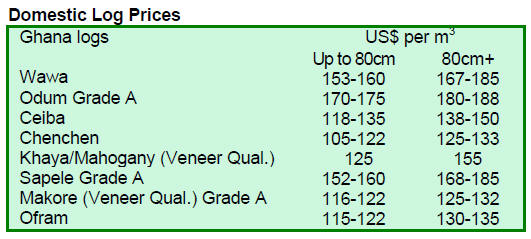
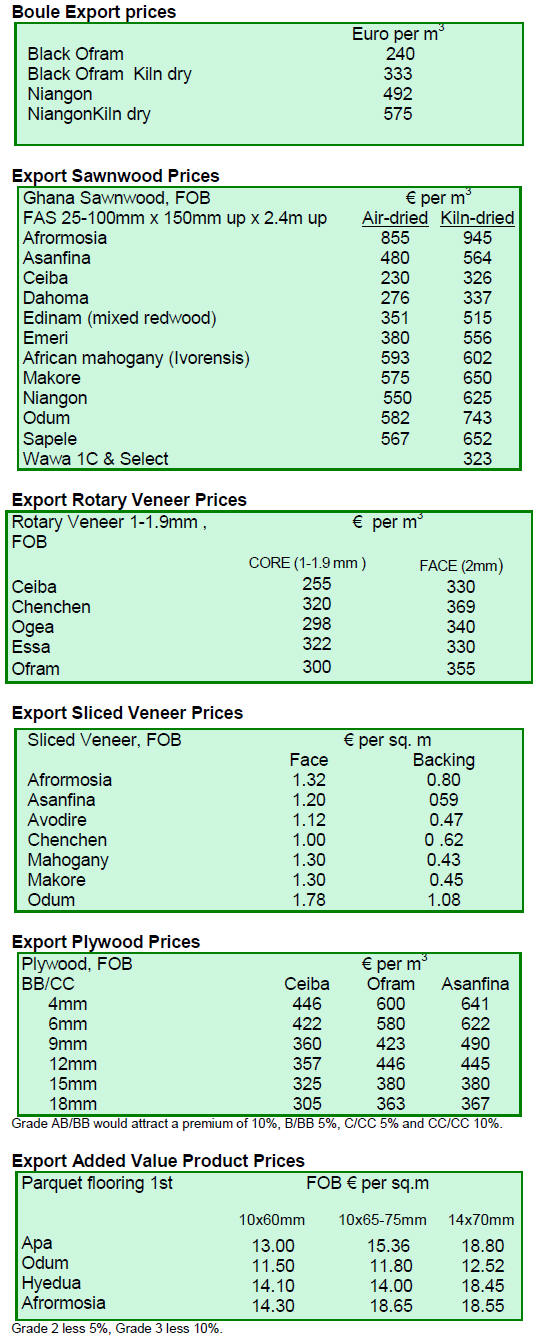
3. MALAYSIA
Furniture makers report better earnings
The recent stabilisation of the EU and US economies,
along with the weaker ringgit, has boosted export sales of
furniture and this has improved the share prices of listed
furniture makers.
Those companies that sell into the Japanese market have
seen orders rise as the Japanese housing market expanded
and as consumers purchased furniture in advance of the
consumption tax increase. 2013 furniture exports were
worth RM7.4 bil., slightly lower than in 2012.
HeveaBoard Bhd, which specialises in high-quality
particle boards and ready-to-assemble furniture saw
earning rise in 2013. Homeritz Corp Bhd reported better
earnings as did Latitude Tree Holdings Bhd and Poh Huat
Resources Holdings Bhd.
SFIA wants support for furniture village
The president of the Sarawak Furniture Industry
Association (SFIA) has said competition from exporters in
China and Vietnam is holding back growth in the domestic
industry and has called on the government for support.
Sim Lee Beng said the Malaysian domestic market is
flooded with imported furniture.
Adding to the problems in the sector is the lack of skilled
workers, inadequate research and the high cost of raw
materials and fixtures. Sim pointed out that young people
are not interested in jobs in the furniture industry despite
the sector having a bright
The association is calling on the government to assist with
the creation of a furniture village in the state so that the
benefits of integration can be enjoyed.
According to the Sarawak Timber Industry Development
Corporation, there around 400 registered furniture
manufacturers in Sarawak and that most produce wooden
furniture.
For more see: http://www.sfia.org.my/
Clarification on domestic log processing quotas
Sarawak Timber Association (STA) general manager Peter
Kho has reiterated that the policy in Sarawak is that 60%
of total log production in the state must be processed
domestically. Kho was responding to some confusion
caused by recent reports which stated Sarawak had
changed the log export quota. Kho reconfirmed that
Sarawak does not apply a log export quota.
Philippines and Thailand major buyers of Sabah
sawnwood
The Sabah Department of Statistics has released timber
export data revealed that for the first two months of 2014,
Sabah exported 35,482 cu.m of sawntimber worth RM
53,011,149 (approximately US$ 16.3 million).
During this period reported the biggest importer of Sabah
sawntimber was Philippines at 6,626 cu.m (or 18.7% of
total exports), followed by Thailand 5,522 cu.m (15.6%)
and China 5,245 cu.m (14.8%).
Exports of sawnwood to Japan amounted to 4,538 cu.m
(12.8%) and exports to Taiwan P.o.C 3,918 cu.m (11.0%).
The main species groups exported were “dark and
light red
meranti and meranti bakau” totaling 10,024 cu.m (or
28.3% of all sawnwood). The next species group of
“Keruing, Ramin, Kapur, Teak, Jelutong,
Kempas,Mengkulang, Balau (Selangan batu)” accounted
for 5,835 cu.m (16.4%). The following are average export
prices (FOB).
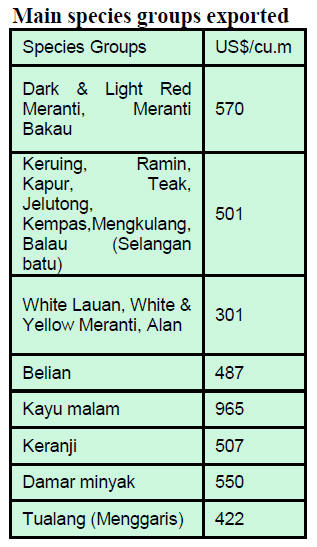
4. INDONESIA
Wood industry relocates to Java to access
plantation
logs
Zulkifli Hasan, Indonesia‟s Forestry Minister recently
highlighted some changes that are taking place in the
sector in relation to where companies are now being
established. He said that in recent years around 400 new
wood processing mills have been established in Java.
Previously it was Papua, Sumatra and Kalimantan that
attracted investment by timber companies. The Minister
attributed the change to the availability of log raw
materials such as sengon, gabon, gmelina and albizia in
Java.
Anggoro Ratmodiputro, Chairman of Asmindo for Central
Java, said that Indonesia could manufacture more high
quality furniture for export if the government was more
supportive of the country‟s labour intensive wood
processing industries.
First International Furniture Expo deemed a success
The first International Furniture Expo (IFEX) ended on 14
March and the organisers say that exhibition stands were
fully booked.
According to UBM, the London based organisers, the
three-day exhibition attracted over 6,000 trade visitors, of
which 2,021 were overseas buyers sourcing Indonesian
furniture for sale in Europe, China, the US and
Australasia.
In a press release UBM says, “ exhibits covered a wide
range of products, from contemporary furniture and massmarket
offerings to traditional, hand-crafted furniture. The
materials used reflected Indonesia's abundant supply of
sustainably-sourced woods, as well as rattan and textiles.
The exhibition also included a rich selection of home
furnishings, decorations and handicraft items.
The international buyers who attended IFEX came from a
total of 108 countries. In descending order, the top 10
countries were: Australia, China, the US, Malaysia,
Singapore, India, the Netherlands, France, Germany and
the UK. Several official buyer delegations visited the
exhibition, including groups from Belgium and Turkey.”
Developing a ‘green economy’
The Center for International Forestry Research (CIFOR)
and the Indonesian Forestry Ministry will host a „Forests
Asia Summit‟ in May which organisers say will attract
Ministers from across Southeast Asia, the private sector,
civil society and development specialists. The aim is to
share experiences on developing a „green
economy‟through better management of forests and
landscapes.
This summit is billed as the largest gathering of its kind in
Asia in recent years.


5. MYANMAR
Last minute rush to beat log ban deadline
As anticipated, the level of March log export shipments
were remarkable as exporters rushed to ship as much logs
as possible before the log export ban became effectiveat
midnight 31 March 2014.
Local observers say that 148 vessels were loaded with
timber in March, double the number in February. It has
been reported that several vessels were only partially full
when they left the port just prior to the deadline.
Up to the midnight deadline trucks were arriving at the
port but many failed to beat the deadline and had to return
with unshipped logs.
It has been reported that the Myanmar authorities stopped
loading operations some 30 minutes before the midnight
deadline and that this caused consternation among some
buyers who had paid for the logs awaiting loading.
The Myanma Timber Enterprise (MTE) had to contend
with loading some 22 vessels simultaneously; about 5 in
mid-stream and 17 alongside the wharves.
Most buyers reported logistical problems during the final
days of March as they attempted to clear and ship cargoes.
At one point there were more than twenty vessels trying to
load at the same time but there were not enough loaders,
cranes and trucks. In addition, because of the intense
demand, trucking and loading charges went up threefold.
Local observers say that after the log export ban was
announced the MTE had urged buyers to quickly arrange
shipping but many buyers either thought that the ban
would be rescinded or the deadline would be extended and
were caught with too many logs to ship as the deadline
approached.
Analysts estimated that as much as 90,000 cu.m of export
logs may remain unshipped but it is still too early to have
accurate figures.
The log export ban was the most drastic action ever taken
by the Myanma Timber Enterprise during its 66 years of
operation. The government had wanted to stop exporting
logs and promote the export of value added items since the
late 1990‟s, but the need to earn foreign exchange meant
the log export trade was allowed to continue.
But as forest resources declined the government had no
choice but to call an end to log exports.
The following table shows the shipments made during the
fiscal year from April 2013 to March 2014.
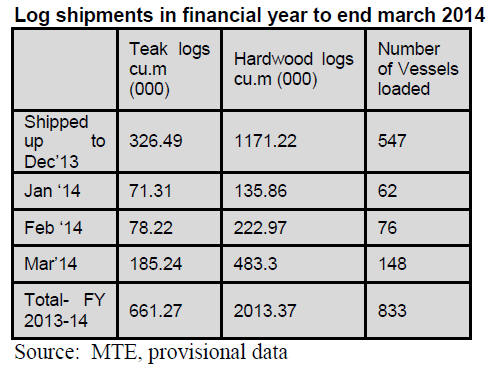
Businesses to close for New Year holidays
April is the beginning of the new fiscal year in Myanmar
as well as the month in which the Myanmar New Year is
celebrated. This year the New Year holidays will last
about 10 days from 12 April.
The MTE is expected to hold a tender and open tender sale
around 28 April. Tender sales are usually conducted on the
last Monday of every month with open tender sales
interspersed during the month.
Logs purchased during the April 2014 tenders will be only
for local manufacturing and as usual will be priced in US
Dollars.
Past log tender prices
The following regular items were sold by competitive
bidding on 10 and 21 March 2014 at the Myanma Timber
Enterprise (MTE) tender hall. April auctions for domestic
endusers will open at month end.
Teak sales
The following grades were sold by competitive bidding on
10 and 21 March 2014 at the Myanma Timber Enterprise
(MTE) tender hall.
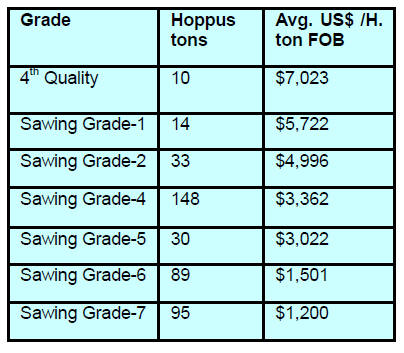
Another Singaporean company commissions mill
An early April issue of the New Light of Myanmar, the
state-run English daily has reported that Concord
Industries Ltd. has commissioned and opened a wood
processing industry in Yangon.
Singapore based Concorde Industries is planning to mill
10,000 tons of wood annually for export to Europe. The
opening ceremony on 30 March was attended by the
Union Minister for Environment Conservation and
Forestry.
6.
INDIA
Rupee firmer against the US dollar
The rupee strengthened more than 3% in the first quarter
of this year, the biggest gain since the third quarter of
2012. To the surprise of analysts the exchange rate hit an
eighth month high of 59.60 per dollar on April 2 on the
back of moves by the Reserve Bank of India to stem the
rate of inflation and correct the current account deficit.
The recent optimistic IMF report on the Indian economy
along with prospects for an increase in investment after the
election is likely to further stimulate capital inflows.
Economic growth forecasts from the IMF
In its latest World Economic Outlook (WEO), the IMF
says it expects the Indian economy to expand by 5.4% in
the 2014-15 financial year and that the pace of growth
could improve to 6.4% in the following year.
India‟s recovery will be supported by a stronger world
economy, improving export competitiveness and policies
encouraging investment says the IMF.
Efforts by the Reserve bank of India to slow the pace of
consumer price inflation are likely to have a lasting effect
and could bring inflation down to 8% in 2014-15 and to
7.5% in 2015-16. For the past fiscal year inflation came in
at 9.5%.
In a press release the IMF said “Overall growth is
expected to firm up on policies supporting investment and
a confidence boost from recent policy actions, but will
remain below trend. Consumer price inflation is expected
to remain an important challenge, but should continue to
move onto a downward trajectory.”
Weak domestic and international demand, high interest
rates and the poor pace at which investments have
proceeded because of delays in government approvals
have added to the problems in the economy.
See:
http://www.imf.org/external/np/tr/2014/tr040814.htm
Launch of new housing market index
The Indian real estate market remains weak as consumers
are still anticipating residential property prices will
continue to fall.
It is difficult to judge trends in the Indian housing market
as statistics and analysis of the market are not widely
available.
Until recently the National Housing Board's RESIDEX
and RBI's Housing Price Index (HPI) were the only
available indexes. The fact that this segment of the
economy is so poorly researched is a surprise as
investment in private residential properties is estimated to
have contributed about 6% to GDP in recent years.
The Indian Institute of Management, Bangalore (IIMB)'s
Century Real Estate Research Initiative (CRERI) has
joined forces with MagicBricks (MB), a major online real
estate portal to fill the data gap on the Indian real estate
market through the publishing of a Housing Sentiment
Index (HSI).
For more see:
http://www.magicbricks.com/iimb-hsi/
The Magicbricks website says “The IIMB MB HSI is a
sentiment index of the Indian real estate market that aims
to capture buyer „mood‟ and serve as a leading indicator of
residential real estate market performance.
The first inaugural report was released in the month of
October 2013 and captured sentiments across eight cities.
The latest report covers 10 cities and includes a
comparative seller‟s survey as well.”
The latest HSI says “the pace of weakening sentiment is
slowing with consumers now understanding that prices
have reached the lowest values and are preparing to buy.
However, a stable political environment could be a trigger
for enhanced transactions.”
E-auction system requires further development
The efforts by the Forest Department to adopt an e-auction
system have run into difficulties and teak sales have been
delayed. Until the problems in the system are addressed to
the satisfaction of the Department and buyers the old
system of „physical‟ bidding was reintroduced for auctions
at the Dangs and Valsad Divisions where approximately
6,000 cu.m of teak and 2,000 cu.m of non-teak hardwoods
were offered for sale.
Average prices recorded at the most recent auction are as
follows:
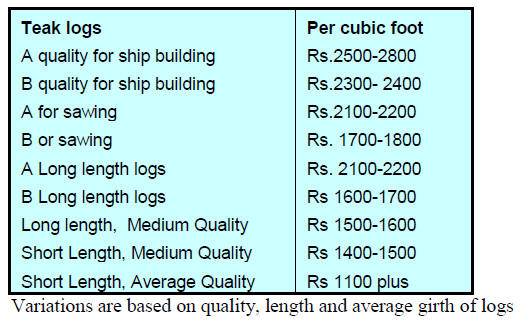
Subdued demand in the domestic building industry
and a
pause in public works as well as private building projects
resulted in lower auction prices. However, almost all log
stocks were sold as sawmills needed to restock, having
utilised previous stocks during the monsoon period when
there are no auctions because harvesting is restricted.
Good quality non-teak hard wood logs such as Haldu
(Adina cordifolia), Laurel (Terminalia tomentosa), kalam
(Mitragyna parviflora) and Pterocarpus marsupium, of 3-4
m length and having girths of 91cms and above were
selling at Rs.600-900 per cu.ft. Medium quality logs
moved at around Rs300-600 per cu.ft.
Due to upcoming elections the next log auctions will be
after 16 May.
Teak sales in Central Indian forest depots
Approximately 3,000 cu.m of teak logs were sold at the
Timarni, Khirakia, Ashapur and Narmada nagar depots in
Central India. This year the monsoon was longer than
usual so logging was affected and the volumes for auction
were lower than normal.
Prices at the recent auctions are shown below.
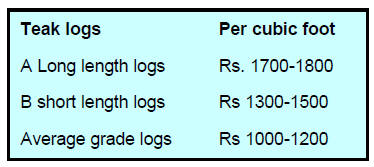
Imported teak prices
The flow of imported plantation teak logs and sawnwood
has been steady but sales of domestic plantation teak from
the Western region were delayed which helped importers
dispose of accumulated stocks of imported teak.
Current C & F prices for imported plantation teak are
shown below.
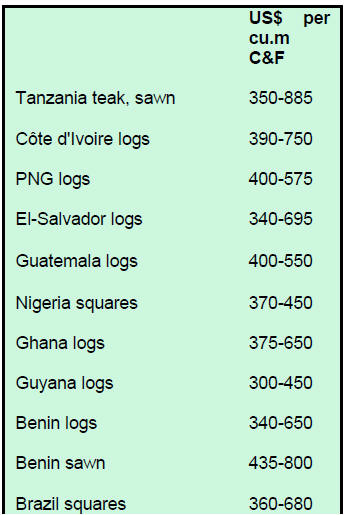
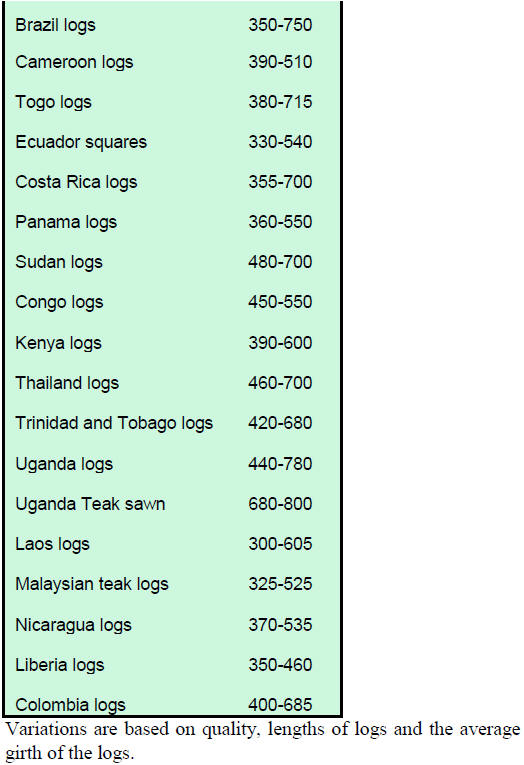
Enduses have to find alternatives to balau
As was reported earlier, demand for balau currently
exceeds the available supplies so that prices have risen.
To fill the gap in availability of balau, species such as
resak which is similar in appearance to balau, is in
demand. Analysts welcome this as a positive development
in utilisation of lesser used species. Red Meranti continues
to be popular with door and window manufacturers.
Prices for air dry sawnwood per cubic foot, ex-sawmill are
shown below.
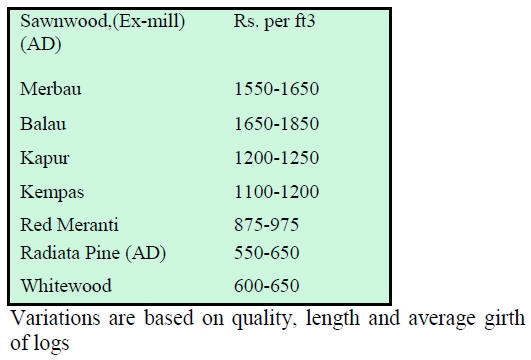
Myanmar teak processed in India
Export demand for teak products is firm but domestic
demand is still slow and prices remain unchanged as far as
sawn teak is concerned.
Prices for logs from Myanmar have risen sharply in recent
weeks as Indian mills accumulated stocks in advance of
the log export ban in Myanmar.
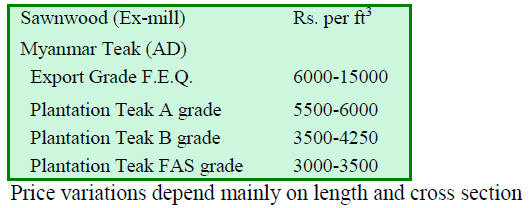
US hardwoods finding wider acceptance
The American Hardwood Export Council has reported an
improvement of 8% in exports of American hardwoods
last year.
American tulipwood logs for production of face veneers
have found a ready market in India as an alternative to the
popular gurjan from Myanmar. It is anticipated that Indian
demand for American hardwoods will rise as the local
millers become more aware of their suitability.
US hickory is being widely used by the Indian tool handle
industry and white oak, walnut, maple and ash are
becoming popular with furniture, door, interior joinery and
flooring manufacturers.
In the Indian market for thermally modified American ash
decking and cladding is expanding.
Imported sawnwood prices
Ex-warehouse prices for imported kiln dry (12% mc.)
sawnwood per cu.ft are shown below.
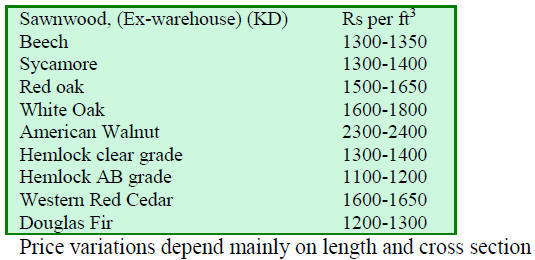
Builders get a boost from rural housing demand
In recent years manufacturers of building materials have
extended their distribution networks in rural India. Access
to rural areas has become easier as the road networks are
improving and construction activity in the rural areas has
expanded.
This year agricultural production was good providing
farmers with more disposable income much of which is
being spent on housing. Rural housing growth has been
given a boost by the rise in Government spending on its
„Indira Awas Yojana project‟ which helps people own
their own home through subsidies.
Expansion in the rural housing market is also good for the
plywood sector which anticipates improvement in the
housing market after the general election.

7.
BRAZIL
New timber enterprise in Acre
In late March the Acre government opened a joint publicprivate
sawmill facility. The new plant is located in Cruzeiro
do Sul municipality and cost around R$ 6.5 million. At full
capacity the mill will be capable of processing 80,000 cu.m of
wood per year and will provide jobs for 350 workers.
Initially logs will be sourced from the Havaí Forest
Settlement Project (PAF-Havaí), located in the municipalities
of Rodrigues Alves and Mâncio Lima. About 80 families in
the PAF settlement have licenses to utilise plots for
agriculture and logs will be sourced from these areas when
cleared.
The company managing the new enterprise is Soar Forest of
Juruá S/A in partnership with the government, through the
Business Agency of Acre (ANAC).
Monitoring of forests under management in Amapá State
Forests under management in the state of Amapá will be
monitored to assess the impact of logging and this will be
supported by the Guiamaflor project. The goal is to monitor
the forest in the area around Porto Grande (102 km from the
capital Macapá).
Staff of the Guiamaflor project will record and
analyse pre
and post-logging activities using methodologies developed in
French Guyana, Amapá and Amazonas.
The Guiamaflor project includes researchers from the
Brazilian states of Amazonas and Amapá, French Guyana
and France, all members of the International Tropical
Managed Forests Observatory. This organization has
conducted similar studies in Africa and Asia.
According to the Brazilian Agricultural Research Corporation
(Embrapa), the monitoring exercise aims to assess the
recovery of logged areas so as to design the most appropriate
forest management practices.
Previous studies in South America indicate that forests in the
Amazon recover well from logging and this is put down to
the high rainfall according to Embrapa.
Furniture exports to Argentina decline
According to the Bento Gonçalves Union of Real Estate
Brokers (SINDIMÓVEIS) Argentina was the main export
market for furniture from the state.
However, exports in 2013 were, once again, lower than a year
earlier and at R$ 9.79 million were down almost 60% on
levels in 2010.
In contrast, furniture exporters in the State of Rio Grande do
Sul are diversifying markets and have had success in new
markets in Latin America such as Colombia, Bolivia and
Peru; in Africa, such as Namibia and Angola; and in the
United Kingdom.
Furniture exports from Rio Grande do Sul account for around
30% of total furniture exports from Brazil which totalled
about US$ 211 million in 2013.
Furniture imports into the state of Rio Grande do Sul in 2013
grew 23% in contrast to the 13% growth for the country as a
whole. China accounted for around a third of all Brazil‟s
furniture imports.
Rondônia will increase planted forest areas
The Secretariat of Environmental Development (SEDAM) in
the State of Rondônia is strengthening the forest sector to
secure an important energy and timber resource for the State.
According to SEDAM, the plan is to increase the forest area
by 75% over three years beginning in 2014.
In 2003 the Rondônia‟s forest sector traded approximately
54,000 cu.m of roundwood from natural forests including
cuiabano pine (Schizolobium amazonicum) and caroba
(Jacaranda cuspidifolia).
Eucalyptus and teak plantations are extensive in the state and
have caught the eye of foreign companies. A Swedish
company already has a contract for the purchase of 6,000
cu.m of teak from Rondônia.
Analysts say the ports in the state (Manaus and Itacoatiara)
have advantages compared to ports in other states mainly in
terms of easy access, fast truck turn-around, efficient loading
and good shipping services to the United States, Europe and
Asia.

8. PERU
Forestry should contribute more to GDP
The head of the General Directorate of Forestry and
Wildlife (DGFFS), Fabiola Muñoz, said the Peruvian
wood products and forestry sector could contribute more
to the economy noting that currently the sector contributes
less than 1% toGDP.
He said "there are 9 million hectares of deforested
land
and 10 million hectares suitable for reforestation and in
each high value timber plantations can be established.
The potential native species for planting were identified as
mahogany, cedar, capirona bolaina, pashaco, and marupa.
Among the exotic species highlighted as having potential
are teak, pine and eucalyptus.
Forest law should be approved by November
The head of the Directorate of Forestry and Wildlife
Ucayali, Marcial Pezo has announced that the forthcoming
concession bidding process will involve new forest areas.
He also mentioned that the forestry law should be
approved in November this year. Issues of concern to
indigenous communities are currently being discussed.
Greater utilisation of Amazon forest resources could
aid war on drug trafficking
On March 27 , the Governing Board of the Association of
Exporters (ADEX), was invited by the President of the
Council of Ministers, René Cornejo, to provide a brief on
the activities of ADEX committees where immediate
government action is required to improve the
competitiveness of different export sectors.
ADEX Chairman, Erik Fischer, welcomed this opportunity
and emphasized that sustainable utilization of the
country‟s Amazon forest could generate 400,000 skilled
and unskilled jobs and that exports could be increased. He
noted that job creation in the Amazon regions of Peru
would combat drug trafficking and illegal mining.

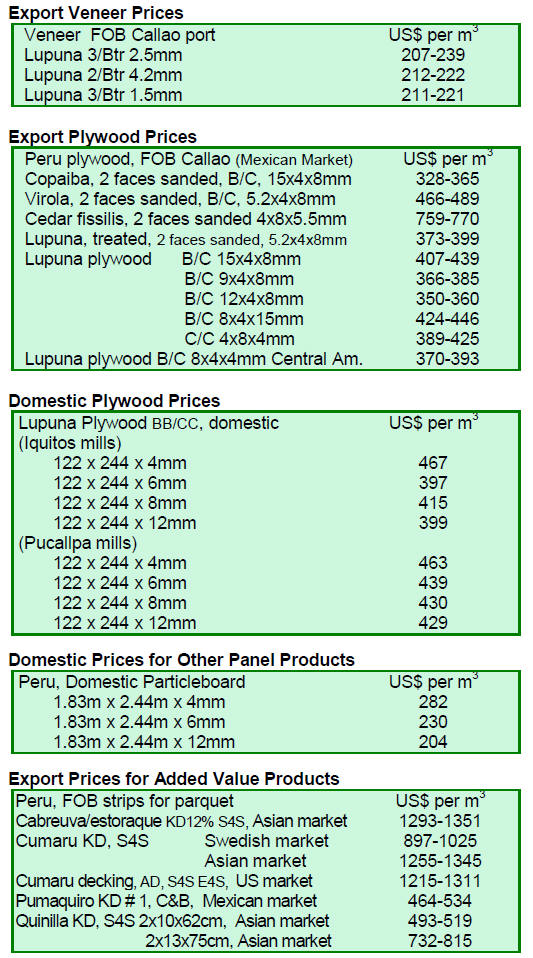
9.
GUYANA
Firm demand in Asian markets
Demand for logs in Asian countries remained strong in the
period reviewed export prices for greenheart and
purpleheart logs were satisfactory.
Greenheart Standard Sawmill quality logs attracted prices
of US$200 per cu.m FOB, up from the US$140 in
previous contracts. Purpleheart Fair Sawmill quality logs
earned US$150 per c.m FOB. There were no exports of
mora logs during the period reviewed.
However exports of wamara (Swartzia leiocalycina) logs
increased and FOB prices ranged from US$120 to US$150
per cu.m.
Sawnwood exports have been encouraging and prices have
been favourable, making a valuable contribution to overall
export earnings. Undressed greenheart (Prime quality)
FOB prices moved from US$954 to US$1,058 per cu.m
and the Middle East and New Zealand were prominent
markets for this product.
Undressed Select quality greenheart FOB prices also
improved from US$910 to US$1,060 per cu.m. Europe
and North America supported Select quality greenheart
exports.
Demand in Caribbean markets lifted the price of
Merchantable Undressed greenheart and prices moved to
as much as US$615 per cu.m FOB. However, in the same
markets prices for Sound quality sawnwood fell from the
US$783 in March to US$594 per cu.m FOB.
Undressed purpleheart Select quality sawnwood prices
ranged from US$721 to US$1,080 per cu.m depending on
the particular market.
Sharp decline in FOB prices for mora
Demand for mora recently weakened. Undressed mora
Select quality sawnwood FOB prices fell sharply from
US$954 to US$500 and Merchantable quality prices
dropped from US$594 to US$509 per cu.m. Australia, the
Caribbean and Europe were the major markets for
Guyana‟s mora sawnwood. In Addition to sawnwood
sales, mora Sleepers/Crossings were exported to the
Caribbean attracting prices as much as US$570 per cu.m
FOB.
Dressed greenheart FOB export prices moved up slightly
in recent contracts from US$1,060 to US$1,102 per cu.m.
Dressed Purpleheart price were unchanged from the
previous period. Dressed greenheart is popular in the
Caribbean markets.
Construction Piling and Transmission Pole prices
climb
Plywood FOB prices eased slightly from US$ 584 to US$
578 per cu.m but continued to maintain a footing in
Central and South American markets.
Greenheart Piling Select category commanded a fair FOB
price in recent contracts, earning US$390 per cu.m, while
in the Sound category attracted a price of US$ 388 per
cu.m. North America was the major market for this robust
timber product.
The Caribbean was the major export destination for Poles
and Posts during the period reviewed. Wallaba Poles
attracted FOB price of US$833 per cu.m. while wallaba
Posts earned US$667 per cu.m FOB.
Marketing Council promoting Guyana’s andiroba
Crabwood (Carapa guianensis) commonly known as
Guyana‟s mahogany is available in commercial quantities
in Guyana. The international trade name for this species is
andiroba.
Crabwood is one of Guyana‟s prime furniture species
being appreciated for its natural rich aesthetic properties. It
is an excellent alternative for Mahogany and can also be
used for interior applications. This highly durable timber is
in great demand on the local market and is being promoted
in international markets.
